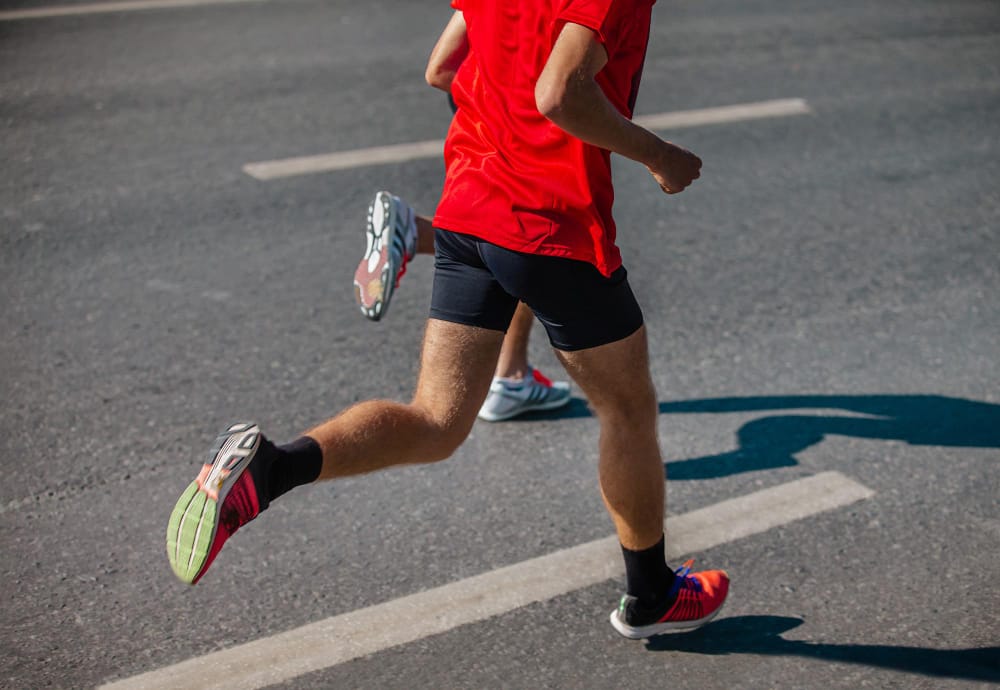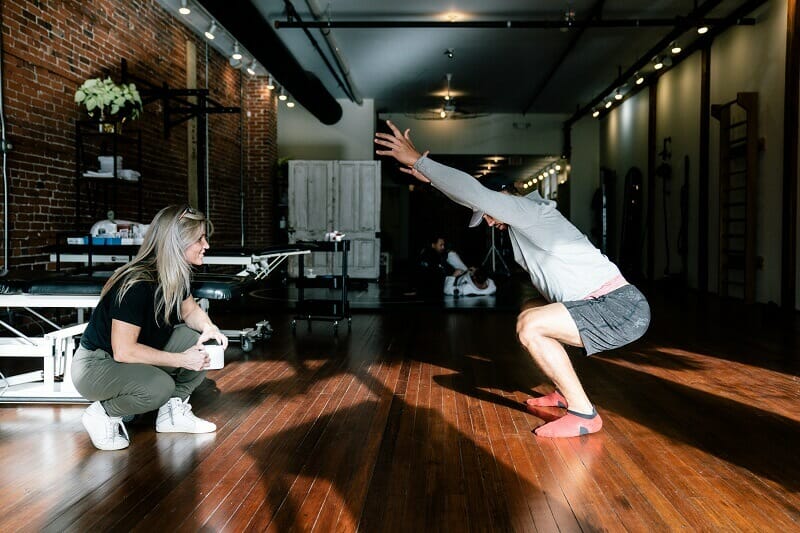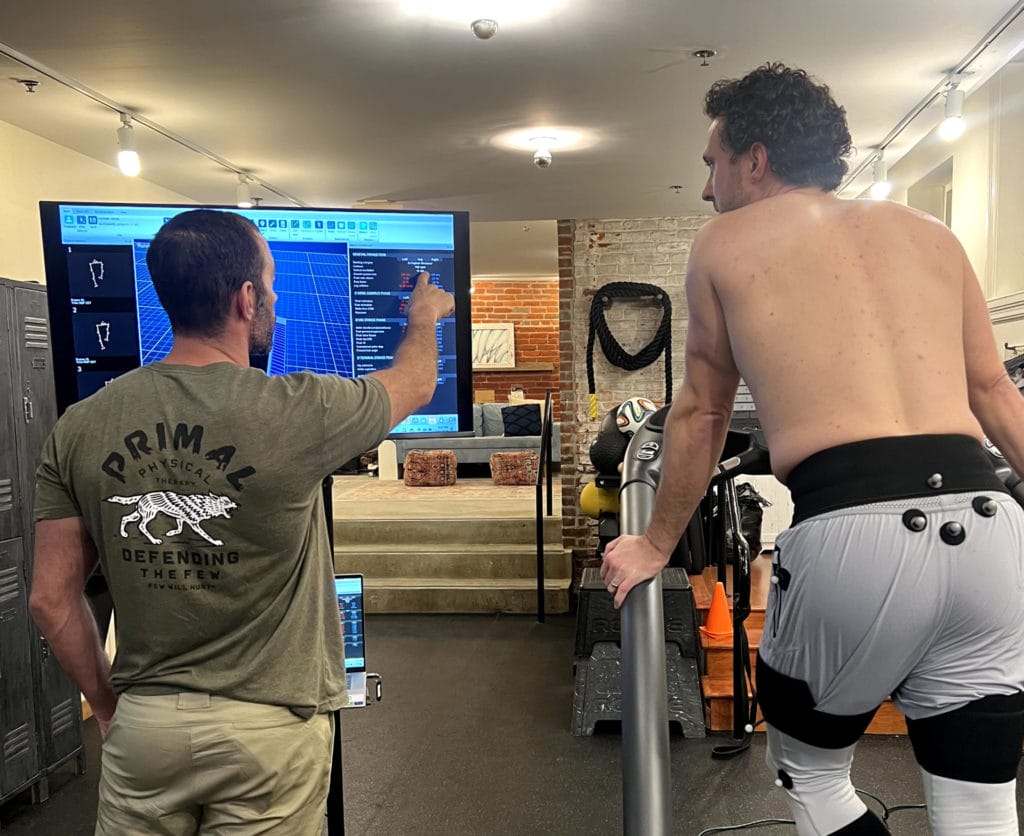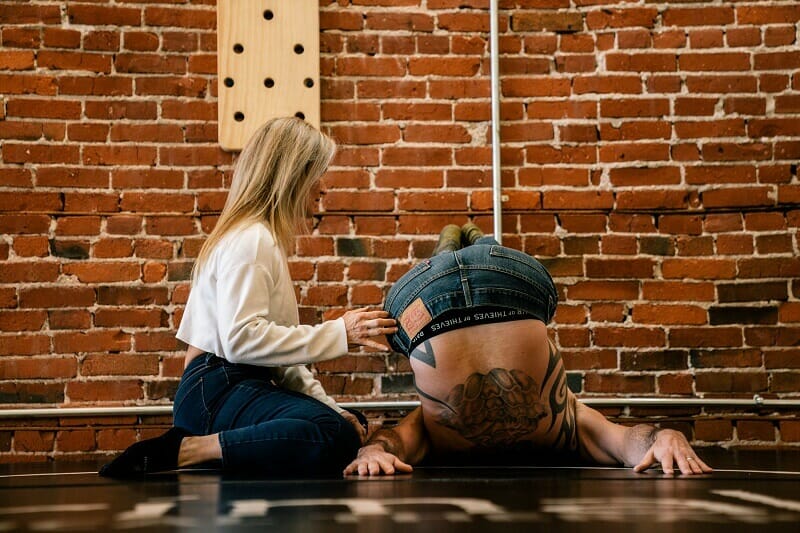Fact Checked By: Dr. JJ Thomas, DPT, CMTPT, FDNS
“It’s not the will to win that matters—everyone has that. It’s the will to prepare to win that matters.” – Paul “Bear” Bryant
Every athlete knows the importance of improving performance and efficiency to be the best version of themselves. Preparation, alongside passion and perseverance, are what make high-achieving athletes special. When it comes to high performance, every second matters while maintaining form to prevent injuries. Most athletes have strict regimens on exercise, diet, recovery tools, and, of course, physical therapy. This is where understanding how gait and running analysis can enhance athletic performance becomes a game-changer.
The technological advancements in the past decade have further allowed physical therapists to capture inefficiencies in running gaits, allowing insight on common injuries and ways to improve performance. Comprehensive gait analysis showing strike patterns, stride length and width, posture, and head positioning all play a role in performance.
Whether a novice runner, running for fun, or high level performance athletes trying to shave off 10 seconds in a marathon, physical therapists are here to optimize the human body’s full potential.

What is Gait and Running Analysis
Historically, human locomotion has been observed and studied dating back to Aristotle (384 BC). Gait can be described as the forward progression of the body as a whole, produced by coordinated, rotary movements of body segments.1 From the point of contact at our feet translating all the way to our head and eye positions, the body is only capable of locomotion through integration of our entire system. When sped up with jogging and running, these systems have a much higher demand biomechanically and could lead to overuse injuries if forces are not distributed efficiently.
Running analysis includes using motion sensors on several parts of the body that graphically are presented to show information on efficiency in running. This motion-capture technology allows detailed analyses of the multiple complex biomechanical components of gait. This allows physical therapists to be more specific in their interventions to reduce stress on joints and tissues, improve force distribution, and improve functional performance.

The Role of Physical Therapists in Gait Analysis
Just as you would see a cardiologist for a heart condition, physical therapists are the movement specialists for all kinetic conditions. Technology including high-speed cameras that record your movement in slow motion to pressure sensors that map foot strike patterns, we use various tools to gather comprehensive data on how you move. Our extensive training on understanding all of the biomechanics of normal and abnormal gait analysis allow us to see the body as a beautiful system of integrating several moving parts to achieve a common goal. Gait analysis is a key tool to allowing physical therapists insight into how each individual’s body moves and where gait abnormalities may stem from.
How Gait and Running Analysis Benefits Athletes
Optimizing Efficiency in Motion
As physical therapists, we are trained to understand the physics of how our body moves through life. Increased stress on joints and tissues caused by gait abnormalities also increased the physical demand of our musculoskeletal system to adapt. A lot of research has been done on energy cost and consumption of different gait abnormalities showing one dysfunction of the ankle or knee can lead to 3-33% more increase in energy consumption.2
Correcting abnormalities and inefficiencies with physical therapy will reduce energy consumption of the musculoskeletal system allowing for improvements in overall performance. Improvements in stride length, posture and alignment, striking patterns, and footwear all can lead to improvements in speed and endurance.
Reducing the Risk of Injuries
Walking and running is so ingrained in human anatomy and physiology, we rarely take a zoomed out perspective. Over the span of 80 years, it has been calculated that a moderately active person at around 7,500 steps per day will take over 216 million steps in a lifetime. That is equivalent to walking around the Earth’s equator 4.5 times! Walking and running is something we do a lot of in our lifetime, so we better learn to do it well.
Several common problems in sitting society today include limited mobility in ankle and hips, poor core strength, bad posture, and poor footwear can lead to common injuries like shin splints, bunions, IT band syndrome. These common injuries are manifestations of misalignments and imbalances in the body causing overuse, overstress, and increased biomechanical demand on joints that may lead to early degeneration. By correcting a body’s alignment and force distribution, we are able to optimize the body’s efficiency as we move around the Earth 4.5 times.
.
Enhancing Recovery After Injuries
It is almost inevitable that everyone will be injured at one time or another in their lifetime. As research has continued to develop into the science of healing, we have a better understanding of our physiological capacity to recover. Early intervention with reduced immobilization times have shown improvements in healing and quicker return to functional activities.3 Gait and running analysis post injury will ensure proper tissue healing and return to normal biomechanics that will overall reduce the risk of re-injury.
For injuries like a torn ACL or meniscus repair, there is protocol for immobilization to facilitate chemical healing early on. This can lead to compensations in the spine, hips, and ankles so that we can still move through life while reducing the strain on injured tissues. As injuries heal, we as physical therapists address the entire kinetic chain to correct any habitual patterns or secondary movement dysfunctions that arise during the recovery process.

How Gait and Running Analysis Works
The best things in life are the result of having and committing to a process.
Whether you’re baking a cake, flying a plane, or performing a gait analysis, the one thing that turns a good result into a great result is using a systematic approach. With a systematic approach, the expert can reproduce the results over and over again.
Here’s the process our clinicians use when they perform a gait analysis:
Perform a full physical therapy evaluation: We start by talking with the patient to hear more about their injury history, listening to their specific limitations, and understanding their goals (both their individual goals and their goals for physical therapy).
Perform a movement assessment: Here, we identify any deficits that might be present anywhere in the kinetic chain. This component is a must for clinicians at Primal, as treating and training the body as a system is paramount in our method. This part of the evaluation helps us “flag” any mobility or stability deficits that might be contributing to the gait deviations we may or may not find in the running specific portion of the eval.
Hit the tread: Now we’re ready to take a look at your body’s motion in action. We prefer to use the 3D Helix camera system to analyze data points with a high degree of accuracy. To do this, we systematically place reflectors on each joint from the pelvis down to the feet. Then, we use the 3D motion capture system to accurately give data from each of your joints during every phase of the gait cycle, and from all three angles. This technology gives us real time data so we can quickly see which areas may or may not be responsible for your injury, but also gives us the ability to improve efficiency of your running performance and even prevent injury in the future.
Review the data: Once your therapist has reviewed all of the data, they will review the results with you and help you understand where your specific limitations might be coming from.
Form coaching: With the knowledge gained from the motion capture data, our therapists will start coaching you immediately on various form cues to improve your efficiency. Common cues you might hear are, “Let’s try leaning your trunk forward just a little.”, or “Let’s work on driving your knees higher.” Some cues relate more to cadence, and we may encourage you to pace your striking pattern to a particular cadence (often cued with a metronome for accuracy). The beauty of this system? We can test your response to the cues immediately through repeated rounds of motion capture.
Homework time: Once we have identified the underlying factors related to your specific gait limitations, we will give you some homework. This will include everything from teaching you how to integrate the form cues while running on your own (between sessions), to which exercises you need to address your overall limitations best.
Follow up: We schedule follow up visits to make sure the process is giving you the results you’re looking for: less pain, better efficiency, and better performance.

Tools and Technology Used
When results matter, Helix 3D Running Analysis delivers. By using advanced algorithms to prioritize injury prevention and performance improvement for each runner. We seamlessly integrate this tool with knowledge from RunDNA’s Certified Running Gait Analyst courses to accurately and effectively help our athletes gain a competitive edge.
To learn more about our 3D helix system, check it out here.
Case Studies: Real-Life Transformations
An example of how gait analysis can enhance is real case studies seen in the studio. One example is a client returning to marathon running postpartum. As a Nike sponsored marathon runner, athletes are eager to return to their sport quickly after drastic life and physical changes.
After thorough movement screening and analysis of gait with walking up to marathon pace speed, we were able to diagnose movement strategies and compensations of the trunk and hips leading to diminished power output. Trunk and hip alignment in running is crucial to developing a strong core movement pattern allowing for increased energy efficiencies required for long distance running. Our client was back marathon racing just 9 weeks postpartum!

PT Exercises and Techniques to Improve Running Gait
- Hip flexor mobility
- Hip extensor strength (glut max/med/min)
- Ankle DF mobility
- Thoracic rotation
- Adductor mobility
We might also include “neuromuscular reeducation” exercises like wall drills to focus on hip drive and fostering positions of strength for pelvic stability.
The Importance of Periodic Gait Analysis
Gait continually evolves and changes with us as we live our lives. While we mention major injuries, inefficiencies in gait, and potential overuse patterns, there are several factors that contribute to our gait and how we move through life.
Even seemingly insignificant injuries such as “missing a step”, slipping and falling on ice, minor car accidents, and even emotional trauma all can contribute to an alteration in our gait. Periodic and annual gait analysis can help facilitate better movement strategies as our bodies change over time.
These small alterations in gait can mean big alterations in gait overtime, causing a snowball effect of inefficiency that will manifest into either a future injury or in the very least, an inefficiency that will impede performance.
The moral of the story? Don’t wait until you have an injury that causes you to have pain when you run. The beauty of a gait assessment is that you can catch a mechanical deficit that is limiting your performance before you’re even aware that it is there.
Step into Better Performance with Gait and Running Analysis
So there you have it.
You want to perform better on your runs? Here are the key takeaways:
- Being proactive and using a team of experts to catch movement and gait deficits before you’re even aware of them will reduce your chance of injury and improve your running performance.
- Find an expert that uses a systematic approach. Take the guesswork out of it. Clinicians that use a systematic approach have refined the process and are experts at getting results and making the results reproducible.
- Technology gives the most accurate results. Could an expert clinician analyze you without a 3D camera system like the one we use? Well, yes. But they will not be able to do so with the high degree of accuracy that they can with the motion capture system. If you’re going to invest your time and money into a gait analysis, do it right.
So if performance on your runs matters to you, take a page from Paul Bryant’s quote. Just willing yourself to “win” isn’t enough. You must will yourself to “prepare” to win.
What better way than getting a formal gait analysis with an experienced physical therapist who can fast track the way you choose to put your efforts into preparing. Maximize your efforts through expert analysis and help.
If you have questions about gait analysis, or about how we do our gait analysis, don’t hesitate to reach out, or schedule an appointment.
References:
-
- Joint Structure and Function: A Comprehensive Analysis, 5e. McGraw-Hill Education; 2011.
The physiological basis of rehabilitation medicine, ed 2, Boston, 1994, Buttersworth-Heinemann.
- Burgess LC, Wainwright TW. What Is the Evidence for Early Mobilisation in Elective Spine Surgery? A Narrative Review. Healthcare (Basel). 2019 Jul 18;7(3):92.